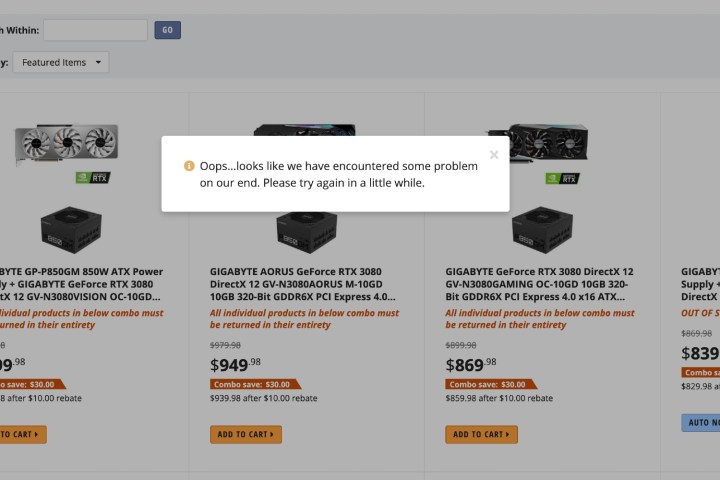After quickly going back in stock, retailer Newegg found itself once again depleted of inventory of the latest RTX and Radeon graphics cards from Nvidia and AMD, as well as the latest AMD Ryzen processors. The retailer’s inventory sold out within minutes of when inventory went live on the site on December 14.
Today’s replenished inventory was publicized on Twitter, following similar restocking events every few days over the past couple of weeks. It seems that retail channels continue to be unable to keep up with widespread demand following short supplies from both AMD and Nvidia.

Newegg’s website lists 22 different packages for the Nvidia RTX 3080 flagship, nine different packages for the enthusiast-class RTX 3090, and 32 packages for both the AMD Radeon RX 6800 XT and 6900 XT. The retailer had listed that it had refreshed inventory for the Nvidia GeForce RTX 3090, 3080, 3070, and 3060 Ti, as well as the AMD Radeon RX 6900 XT and 6800 XT GPUs.
Rather than offer stand-alone graphics cards for sale, Newegg’s GPU packages are often sold as part of a bundle, which comes with additional peripherals, like a power supply unit (PSU), system memory, or fans.
The strategy means that Newegg was able to move PC components along with the GPUs, forcing desperate gamers to purchase a pricier bundle if they want to acquire a new GPU now. This also
Gamers on Twitter were not pleased with this bundling strategy. Twitter user @Onlyonefonz wrote: “Hey @Newegg if you’re wondering why everyone hates you, and gives you the middle finger, it’s because you gave us one first with these anti-consumer combos.”

On the CPU side, Newegg’s social team claimed that it had inventory available for the Ryzen 5950X, 5900X, 5800X, and 5600X.
It’s unclear how many cards and processors Newegg had available, but given the recent refresh trend, it appears that the retailer is receiving fresh inventory every few days.

Lucky Twitter user @Beaaron1 claimed he was able to purchase a GPU through this most recent drop by using the retailer’s app.
“I got one,” the user wrote. “Guys I feel the pain that you are all enduring but let me be the example you all need. I never thought I’d get one. I’ve spent so much time just trying to get ANY of the 30 series card. “something went wrong” is what I saw every time I blinked. Never lose hope.”
I got one!! Guys I feel the pain that you are all enduring but let me be the example you all need. I never thought I’d get one. I’ve spent so much time just trying to get ANY of the 30 series card. “something went wrong” is what I saw every time I blinked. Never lose hope. pic.twitter.com/3rWdPGMv5v
— Beaaron (@Beaaron1) December 12, 2020
Potential buyers on Twitter claim that Newegg isn’t protecting its restocking efforts against bots, a problem that has plagued the release of new GPUs for the past few months. Units on eBay have been selling for nearly double the cost, racking up loads of money in scalped products.
Newegg disputes the claim that bots are causing the rapid sell-outs. “We stop bots all day every day,” the retailer tweeted. “We also increase bot protection on these popular launches. The issue is the short supply and high demand. A LOT of people want some scarce products with limited supply. The amount of traffic we see on our site during these launches is incredible.”
Bots or not, Nvidia had most recently stated that component shortages for its
Editors' Recommendations
- Intel Battlemage graphics cards: release date speculation, price, specs, and more
- Nvidia RTX 50-series graphics cards: news, release date, price, and more
- The sad reality of AMD’s next-gen GPUs comes into view
- You shouldn’t buy these Nvidia GPUs right now
- 5 GPUs you should buy instead of the RTX 4070



